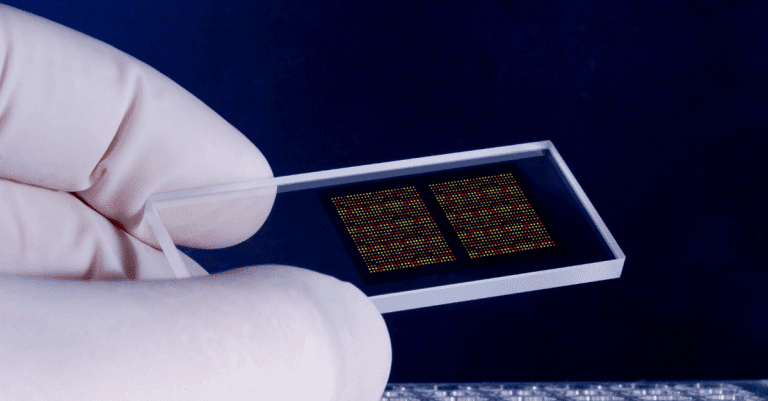Microarray Data Analysis
- 13th June 2022
- Posted by: Breige McBride
- Categories: Gene Expression Analysis, Microarray

If you are unsure what microarray data analysis is, this is the blog for you. For those who are completely new to microarrays, we detail what they are, what they look like, and what researchers can use them for. Then we go on to explain exactly what microarray data analysis is.
What is a microarray?
A microarray is a laboratory tool for detecting gene or protein expression or for tracking the interactions of proteins. It is a solid surface, such as a microscope slide, which is printed with thousands of spots in a grid pattern. There are two main types of microarrays, DNA microarrays and protein microarrays. Spots on a DNA microarray will contain a DNA sequence which represents a gene. Meanwhile, the spots on protein microarrays will contain antigens or antibodies.
What does a microarray look like?
This is an enlarged illustration of what a microarray looks like. You can see two rectangles composed of multicoloured spots, on a slide.

In reality, a microarray slide may have an entire grid of rectangles on it and they will be much smaller, containing thousands of spots. This video gives a much more realistic image of a DNA microarray and explains the reason behind the different coloured spots.
What does a microarray measure?
DNA Microarrays measure gene expression levels for a large number of genes, simultaneously. Researchers can also use them to genotype multiple regions of a genome. Protein microarrays, also known as immunoassays, monitor the interactions of proteins and determine their function on a large scale.
What are the applications of microarrays?
In addition to detecting gene expression levels, microarrays have a variety of applications. We can use them to detect gene mutations, assess gene copy number and to detect chromosomal copy number changes via comparative genome hybridization. Protein microarrays (immunoassays) can detect the presence of specific proteins in test samples such as blood. Researchers also use microarrays for sequencing by hybridization, resequencing and also as SNP genotyping platforms. Due to the various applications of microarrays and the data they can produce, microarray data analysis can inform drug discovery and development.
To learn more about the applications of microarrays, we recommend reading this article from Current Protocols in Molecular Biology and consulting this microarray literature survey.
What is microarray data analysis?
Microarray slides, with their many spots of DNA, antibodies or antigens, are read by a microarray reader. A microarray reader ‘reads’ the microarrays and produces raw data. This raw data then needs to be analysed and interpreted to reveal the biological insights contained within the microarrays. This is microarray data analysis.
Bioinformaticians are particularly good at performing microarray data analysis. This is because they have the computational resources necessary for analysing the data that microarrays produce; and they also have the biological knowledge necessary to interpret that data for insights which are biologically meaningful.
Need microarray data analysis?
If you are looking for microarray data analysis you are in the right place. Fios Genomics bioinformaticians can analyse data from all array platforms. For example, we regularly analyse CEL format array data from Illumina, Agilent and Affymetrix readers. In fact, our analysis pipelines cover all array platforms and we can adjust them to apply the most appropriate techniques in any situation, e.g. Robust multi-array average (RMA) normalisation for Affymetrix data. Contact us to discuss your microarray data analysis project today!
Author: Breige McBride, Content and Social Media Manager, Fios Genomics
Reviewed by Fios Genomics Bioinformatics Experts to ensure accuracy
See also
RNAseq or Microarray: Which one fits best?
Gene Expression Analysis from Fios Genomics
Predictions for Bioinformatics in 2022
Leave a Reply
You must be logged in to post a comment.

